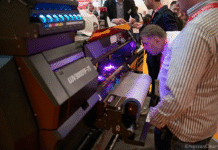
At the recently concluded Heimtextil India 2017 event in Delhi, DuPont Advanced Printing showcased its pigment and dye sublimation digital textile inks for home textile applications. Designed primarily for cotton textile roll-to-roll printing, the dye sublimation inks are the most recent addition to the DuPont Artistri digital printing inks portfolio. The DuPont Artistri Xite S1500 dye sublimation ink in India was recently launched in India to deliver brighter colors and shorter production cycles.
“DuPont is extremely strong in the field of ink and chemistry. At the event, we predominantly focused on pigment and sublimation inks. We believe pigment ink is the next good thing to happen in the digital textile printing industry. You can see everybody talking about reactive and dispersed inks, which already have a huge market. However, pigment ink is the next level ink because of its simpler use, ability to work with printers having various viscosity piezo-electric printheads, and many more interesting features. In India, however, pigment ink has a niche market—the reason why we are trying to create awareness about the brilliant features and advantages of DuPont pigment inks,” says Prasenjit Das, sales manager – South Asia cluster, DuPont Advanced Printing. DuPont Artistri pigment inks provide excellent results including color intensity, batch-to-batch consistency and low printhead failure.
Pigment inks being in the formative stages in India, there are many challenges for DuPont. “People are comfortable using the existing reactive and dispersed inks. They don’t want to shift to a new ink which calls for a change of processes and technological infrastructure. Right now, people are not ready to invest in this. However, with rising competition and a growing concern for environmental issues, we can see more and more people shifting to pigment inks,” says Das.
“Different segment of inks bring with them their own set of challenges. If we talk about reactive and dispersed inks, the competition is high and price is an issue because of the mass volume. Of course, quality plays an important role and that is the reason why we have an edge over our competitors,” adds Das. He agrees that when it comes to pigment inks, the challenge is about developing a whole new market.















